北师大版《初中英语》七年级上册get ready DP1
北师大版七年级英语上册Get Ready E(Part I) 课件 (共20张PPT)

Weimin: Come in, Jeff. This is my room.
Jeff: Wow! It’s big. Look at those balls! Weimin: Oh, you know I love ball games. Jeff: And what are these? Weimin: They’re my English tapes. Jeff: I see. You have so many Harry Potter books. Weimin: Yes, those are the old ones. This is the new one.
Where is the coat/ball/book/clock?
Where are the shoes/socks/tapes?
It’s on the bed.
Reading
Read the dialogue. Are the sentences true (T) or false (F)?
F F T F
B: He’s my grandpa. He’s 70 years old.
指示代词 表示“这个,那个,那些”等明确指示人或事物
用法 1
this,that用于指代单数名词;these,those用于 指代复数名词。
例: This is my book. 这是我的书。
I don’t like these. 我不喜欢这些。 What I want is that. 我想要的就是那个。
Language Focus
指示代词(单数)
This is my new book.
This book is new.
北师大版初中英语七年级上册知识讲解--- Review of Get ready and Units 1-2
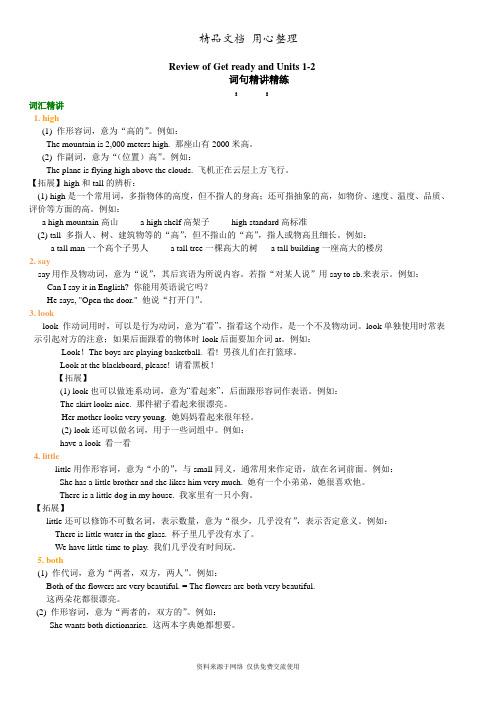
Review of Get ready and Units 1-2词句精讲精练::词汇精讲1. high(1) 作形容词,意为“高的”。
例如:The mountain is 2,000 meters high. 那座山有2000米高。
(2) 作副词,意为“(位置)高”。
例如:The plane is flying high above the clouds. 飞机正在云层上方飞行。
【拓展】high和tall的辨析:(1) high是一个常用词,多指物体的高度,但不指人的身高;还可指抽象的高,如物价、速度、温度、品质、评价等方面的高。
例如:a high mountain高山 a high shelf高架子high standard高标准(2) tall 多指人、树、建筑物等的“高”,但不指山的“高”,指人或物高且细长。
例如:a tall man一个高个子男人 a tall tree一棵高大的树 a tall building一座高大的楼房2. saysay用作及物动词,意为“说”,其后宾语为所说内容。
若指“对某人说”用say to sb.来表示。
例如:Can I say it in English? 你能用英语说它吗?He says, "Open the door." 他说“打开门”。
3. looklook 作动词用时,可以是行为动词,意为“看”,指看这个动作,是一个不及物动词。
look单独使用时常表示引起对方的注意;如果后面跟看的物体时look后面要加介词at。
例如:Look!The boys are playing basketball. 看! 男孩儿们在打篮球。
Look at the blackboard, please! 请看黑板!【拓展】(1) look也可以做连系动词,意为“看起来”,后面跟形容词作表语。
例如:The skirt looks nice. 那件裙子看起来很漂亮。
期末复习Get+ready 北师大版英语七年级上册

【重点句型】
4.你来自哪里? 5. 我来自…… 6. 他/她/它来自…… 7. 你们/我们/他们来自……
【重点句型】
4.Where are you from? 你来自哪里? 5.I’m from ... 我来自…… 6.He/She/It is from ... 他/她/它来自…… 7.You/We/They are from ... 你们/我们/他们来自……
【重点短语】
1.be from 2.good morning 3.good afternoon 4.good evening 5.good night 6.in the morning/afternoon/evening 7.listen to music 8.be late for
来自 早上好 下午好 晚上好 晚安 在早上/下午/晚上 听音乐 迟到
基础练习
二、根据句意和首字母提示,补全单词,注意使用其正确形式。 1. Jerry does a lot of housework today. He is t_______. 2. Nancy says she isn't l_______ for class. 3.You say s_______ and I say go, go, go. 4. N_____ to meet you. 5. Good n_______ . 6. Are you f_______ the United Kingdom? 7. Sally and Rick are John's f_______ .
重难点知识讲解
【解析】在以上例句中,be 动词随主语(I,you,Nancy)的不同而发生 变化,形成主谓一致关系。有顺口溜:“我用am, 你用are,单(数) 用is,复(数)用are',可以帮助记忆。
北师大版英语七年级上册GetReadyDYourClassroomPartⅠ(第一课时)优秀教学案例

3.学生能够正确对待学习中的困难,勇于挑战自我,培养坚持不懈的精神。
4.学生能够认识到学习英语的重要性,树立正确的学习观念,为未来的学习和生活打下坚实基础。
作为一名特级教师,我深知教学目标的重要性。在制定教学目标时,我注重将知识与技能、过程与方法、情感态度与价值观三者紧密结合,以期全面提升学生的英语素养。在教学过程中,我将密切关注学生的学习进展,不断调整教学策略,确保每位学生都能达到本节课的教学目标。
二、教学目标
(一)知识与技能
1.学生能够正确认读和书写本节课所学的日常用品单词,如:desk, chair, computer, door等。
2.学生能够运用所学生日常用品的单词进行简单描述和交流,如:I have a computer. Do you have a chair?
3.学生能够通过观察图片,运用形容词对日常用品进行描述,如:The desk is long. The chair is comfortable.
4.教师设计一些练习题,让学生运用所学知识进行填空、选择等,巩固他们对单词和句型的掌握。
(三)学生小组讨论
1.教师将学生分成小组,每组分配一张教室的图片,要求学生用英语描述他们小组的教室。
2.学生小组内互相交流,讨论如何用英语描述教室物品,鼓励他们用所学单词和句型进行表达。
3.教师巡回指导,给予学生必要的帮助和提示,鼓励他们积极参与讨论,培养他们的口语表达能力。
5.教学目标明确:教师在制定教学目标时,将知识与技能、过程与方法、情感态度与价值观三者紧密结合,全面提升学生的英语素养。在教学过程中,教师密切关注学生的学习进展,不断调整教学策略,确保每位学生都能达到本节课的教学目标。
北师大版英语七年级上册Get Ready B Period1 精品教案

学校开设的课程名称;阅读获取信息.
教学难点
运用表达个人信息的语句,问答吉姆的朋友林欣欣和林洋洋的个人信息情况。
教学方法
引 领启发法
教学准备
ppt students’ sheet
教
学
过
程
教师活动设计
学生活动设计
设计意图
时间安排
Step1
Ask Ss to talk about the subjects taught at school with the help of the pictures.
Ask Ss to check the answers in pairs by asking and answering the following questions.
How old is Xinxin/Yangyang?
Where is she/he from?
Ask Ss to listen to the tape.
Ss Work inpairs.Role-playyouand Jim. Make a dialogue to get the information about Jim and Xinxin or Yangyang
Finish the homework
利用图片,激活学生已知的课程名称,丰富话题词汇。
听录音,模仿语音语调,培养语感。
以角色扮演的形式,进一步内化课文信息,进行基于课文内容的语言输出,初步运用所学语言。
巩固课上所学
8
5
18
3’
10
1
板
书
设
计
课
后
反
思
目标基本达成,角色扮演进行语言输出环节进行得很顺利。
初中英语北师大版七年级上册Get Ready B Your Friends Part 1 教学设计
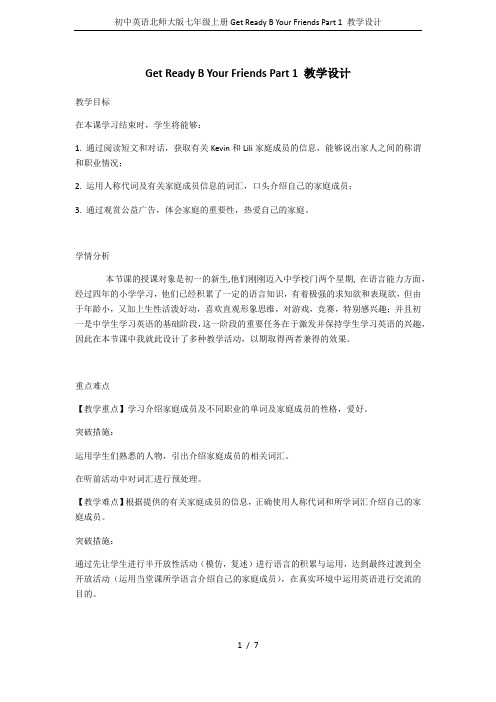
Get Ready B Your Friends Part 1 教学设计教学目标在本课学习结束时,学生将能够:1. 通过阅读短文和对话,获取有关Kevin和Lili家庭成员的信息,能够说出家人之间的称谓和职业情况;2. 运用人称代词及有关家庭成员信息的词汇,口头介绍自己的家庭成员;3. 通过观赏公益广告,体会家庭的重要性,热爱自己的家庭。
学情分析本节课的授课对象是初一的新生,他们刚刚迈入中学校门两个星期, 在语言能力方面,经过四年的小学学习,他们已经积累了一定的语言知识,有着极强的求知欲和表现欲,但由于年龄小,又加上生性活泼好动,喜欢直观形象思维,对游戏,竞赛,特别感兴趣;并且初一是中学生学习英语的基础阶段,这一阶段的重要任务在于激发并保持学生学习英语的兴趣,因此在本节课中我就此设计了多种教学活动,以期取得两者兼得的效果。
重点难点【教学重点】学习介绍家庭成员及不同职业的单词及家庭成员的性格,爱好。
突破措施:运用学生们熟悉的人物,引出介绍家庭成员的相关词汇。
在听前活动中对词汇进行预处理。
【教学难点】根据提供的有关家庭成员的信息,正确使用人称代词和所学词汇介绍自己的家庭成员。
突破措施:通过先让学生进行半开放性活动(模仿,复述)进行语言的积累与运用,达到最终过渡到全开放活动(运用当堂课所学语言介绍自己的家庭成员),在真实环境中运用英语进行交流的目的。
教学过程.【导入】Get Ready C Part IStage 1 Warm-upStep 1 : Everyday EnglishQs: What’s the date today?How many people are there in your family?...Students answer teacher's questionsPurposes: To active the words of family membersStep 2:T brings in some pictures and asks Ss to talk about the family members in each picture in order to lead in the topic of this period—Your Family.Students talk about the family members.Purposes:To lead in the topic: Family【Stage 1设计说明】这部分听前活动的设计源自对本节教学内容和学生特点的分析,为之后的听力输入和口头输出做了两方面的准备。
北师大版七年级英语上 Get ready topic D your classroom教学课件 (共19张PPT)

What's this in English? It is a DVD player.
What's this in English? It39;s this in English? It is a dictionary.
What's this in English? It is an eraser.
pencil exercise book
book
blackboard
picture
shelf door
dictionary
desk
pen
erase
ruler
r
chair
Games
Take out a picture in this box and make up a dialogue with your partner by using what we have learnt today.
What's this in English? It is a tape recorder.
What's this in English? It is a door.
What's this in English? It is a schoolbag.
What's this in English? It is a plant.
What's this in English? It is a picture.
What's this in English? It is a ruler.
What's this in English? It is a blackboard.
What's this in English? It is a chair. How do we spell it? C-H-A-I-R
北师大版英语七年级上册Get Ready C Period1 精品教案

Get Ready C Period1 精品教案课型Reading 教学课题Get Ready C Your Family总课时:4 第 1 课时教学目标在本课学习结束时,学生能够:1.能听,说,读有关家庭成员及工作的词汇及意义。
2.能运用Who’s this/ that? That’s / This is…, What does he/she do? He/She’s…等重要表达口头谈论莉莉的家庭成员的信息。
3.积极参与课堂活动。
教学重点有关家庭成员及工作的词汇及意义。
询问别人的职业的句型:What does he/she do? He/She’s…教学难点如何引导学生掌握本课词汇和句型及口头谈论莉莉的家庭成员的信息教学方法引领启发法教学准备p pt students’ sheet教学过程教师活动设计学生活动设计设计意图时间安排Step1Show a family photo:Point to a woman and say“This is my mum.” Thenpoint to someone else in thephoto andAsk “Who’s this ?”Askstudents to guess your familyLook at the family photoThink and try to say thefamily members with theteacher’s help.Read the key words about以一全家福激活学生已知的家庭成员名称学生跟读词5’2’members. Write the names of the family members on the board as the students say themPlay the recording for students to listen and read the key words about family members after it.Step2Say: you’ve k nown my family members now. Then show a photo of Kevin and say this is our new friend, Kevin. Do you want to know his family members? Then ask them to look at Kevin’s family photos. First give an example, and then ask the students to read the text and label the photos, then check in class.Step3Play the recording for the family members and try toremember them.Read the text and label thephotos, then check in class.Read after the recordingRead the text by themselvesDo “ask and answer”Listen and read the key汇,进一步记忆词汇,熟悉词汇的发音。
北师大版《初中英语》七年级上册Get Ready D P1B

Where is Garfield? It’s next to the clock.
Where is Garfield? It’s under the tree.
Where is Garfield? It’s between the piano and the chair.
Guessing game.
Listen and check the answer.
Let’s check the answer.
under
in
behind
on
between
next to
Where is the cat?
under
It’s under the table.
Where is the cat?
in
It’s in the closet.
Thank you !
Welcome to my room!
in
behind
next to
under
on
between above beside
My room
This is my room. In my room, there is a bed behind the door. There is a football under the bed. There is a lamp next to the bed. There is a table between the lamp and the chair. There is a radio and some books on the table. There is a picture above the table. There is a tea table in the corner. There is a piano beside the table. My room is not very big, but it’s clean and tidy.
北师大版《初中英语》七年级上册Get ready A part1

Where She
Where It
Where They
Is he ?
Is she ?
Is it?
Are they….?
• • • • • • • • • •
I ____ am from china. is from the United Kingdom. She ____ is from the United States. He _____ are from Australia. They _____ are from Canada. Tom and Mary _____ is Jenny ______ from France. are you from? Where _____ Where _____ are they from? is she from? Where _____ Are you from China? _____
Get ready A Part 1 第一课时
Aims
1.At the end of the class you will be able to use the sentences “Where are you from? I am from…?” Are you from…? Yes, I am… No, I’m not.to interview your classmates. 2.You will be able to listen, read and spell the words “Australia, Canada, China”. Listen and read the phrases “the United Kingdom, the United States” 3. You will be able to listen, read, and write the letters “Aa, Bb, Cc, Dd, Ee, Ff, Gg”
初中英语北师大版七年级上册《Get Ready D Your Classroom Part I》优质课教案公开课教师面试试讲教案
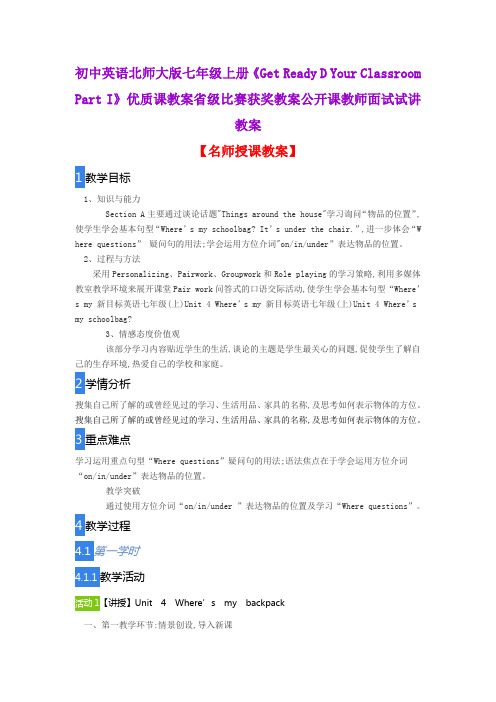
初中英语北师大版七年级上册《Get Ready D Your Classroom Part I》优质课教案省级比赛获奖教案公开课教师面试试讲教案【名师授课教案】1教学目标1、知识与能力Section A主要通过谈论话题"Things around the house"学习询问“物品的位置”,使学生学会基本句型“Where’s my schoolbag? It’s under the chair.”,进一步体会“W here questions”疑问句的用法;学会运用方位介词"on/in/under”表达物品的位置。
2、过程与方法采用Personalizing、Pairwork、Groupwork和Role playing的学习策略,利用多媒体教室教学环境来展开课堂Pair work问答式的口语交际活动,使学生学会基本句型“Where’s my 新目标英语七年级(上)Unit 4 Where’s my 新目标英语七年级(上)Unit 4 Where’s my schoolbag?3、情感态度价值观该部分学习内容贴近学生的生活,谈论的主题是学生最关心的问题,促使学生了解自己的生存环境,热爱自己的学校和家庭。
2学情分析搜集自己所了解的或曾经见过的学习、生活用品、家具的名称,及思考如何表示物体的方位。
搜集自己所了解的或曾经见过的学习、生活用品、家具的名称,及思考如何表示物体的方位。
3重点难点学习运用重点句型“Where questions”疑问句的用法;语法焦点在于学会运用方位介词“on/in/under”表达物品的位置。
教学突破通过使用方位介词“on/in/under ”表达物品的位置及学习“Where questions”。
4教学过程4.1第一学时教学活动1【讲授】Unit 4 Where’s my backpack一、第一教学环节:情景创设,导入新课。
七年级英语北师大版上册GetReadyAYouPartⅠ(第一课时)教学设计
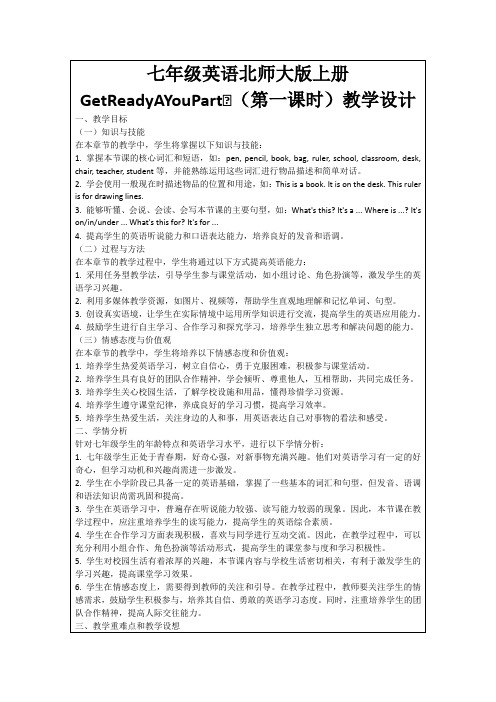
(三)学生小组讨论
1.教师将学生分成小组,每组选择一个物品,用英语进行描述,包括物品名称、位置和用途。
2.学生在小组内进行讨论,互相提问、回答,共同完成描述任务。
3.教师巡回指导,关注每个学生的参与情况,给予适当的帮助和指导。
4.各小组展示成果,其他学生认真聆听,互相学习,共同提高。
6.学生利用网络或英语学习软件,自主查找与学校生活相关的英语素材,如:歌曲、故事、图片等,丰富英语学习资源,提高学习兴趣。
7.家长鼓励孩子用英语进行家庭交流,如:描述晚餐、谈论周末计划等,培养孩子的英语口语表达能力。
作业布置要求:
1.学生在完成作业时,要注意书写规范,养成良好的学习习惯。
2.家长要关注孩子的学习进度,协助孩子完成作业,并及时与教师沟通,共同促进孩子的英语学习。
难点:正确运用一般现在时进行物品描述和简单对话,注意动词第三人称单数的用法。
2.重点:培养学生的英语听说能力和口语表达能力。
难点:提高学生的读写能力,尤其是单词拼写和句子书写。
3.重点:激发学生的学习兴趣,培养良好的学习习惯。
难点:引导学生克服学习中的困难,树立自信心,积极参与课堂活动。
(二)教学设想
2.教师通过实物展示,让学生物品位置和用途的句型,如:What's this? It's a ... Where is ...? It's on/in/under ... What's this for? It's for ...
(四)课堂练习
1.教师设计一些练习题,如:填空、选择、连线等,让学生巩固所学词汇和句型。
2.教师呈现一组图片,要求学生用一般现在时描述图片中的物品,如:“This is a book. It's on the desk. It's for reading.”
北师大版英语七上Get Ready Topic D your classroom 教学设计1
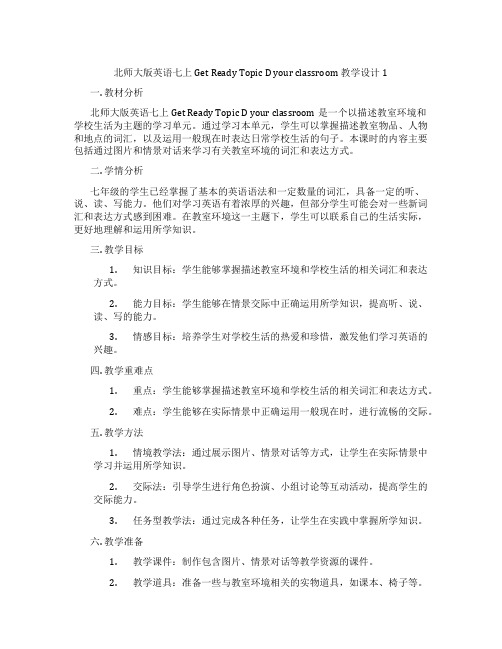
北师大版英语七上Get Ready Topic D your classroom 教学设计1一. 教材分析北师大版英语七上Get Ready Topic D your classroom是一个以描述教室环境和学校生活为主题的学习单元。
通过学习本单元,学生可以掌握描述教室物品、人物和地点的词汇,以及运用一般现在时表达日常学校生活的句子。
本课时的内容主要包括通过图片和情景对话来学习有关教室环境的词汇和表达方式。
二. 学情分析七年级的学生已经掌握了基本的英语语法和一定数量的词汇,具备一定的听、说、读、写能力。
他们对学习英语有着浓厚的兴趣,但部分学生可能会对一些新词汇和表达方式感到困难。
在教室环境这一主题下,学生可以联系自己的生活实际,更好地理解和运用所学知识。
三. 教学目标1.知识目标:学生能够掌握描述教室环境和学校生活的相关词汇和表达方式。
2.能力目标:学生能够在情景交际中正确运用所学知识,提高听、说、读、写的能力。
3.情感目标:培养学生对学校生活的热爱和珍惜,激发他们学习英语的兴趣。
四. 教学重难点1.重点:学生能够掌握描述教室环境和学校生活的相关词汇和表达方式。
2.难点:学生能够在实际情景中正确运用一般现在时,进行流畅的交际。
五. 教学方法1.情境教学法:通过展示图片、情景对话等方式,让学生在实际情景中学习并运用所学知识。
2.交际法:引导学生进行角色扮演、小组讨论等互动活动,提高学生的交际能力。
3.任务型教学法:通过完成各种任务,让学生在实践中掌握所学知识。
六. 教学准备1.教学课件:制作包含图片、情景对话等教学资源的课件。
2.教学道具:准备一些与教室环境相关的实物道具,如课本、椅子等。
3.练习题:设计一些针对本节课内容的练习题,用于巩固所学知识。
七. 教学过程1.导入(5分钟)教师展示一些教室的图片,引导学生谈论他们所熟悉的教室环境,激发学生的学习兴趣。
2.呈现(10分钟)教师通过课件展示本节课的主要词汇和句子,如“This is our classroom. This is a book. That is a blackboard.”等,同时引导学生跟读,确保学生正确掌握。
北师大版英语七年级上册Get Ready C Period1 精品教案

Step2
Say: you’ve known my family members now. Then show a photo of Kevin and say this is our new friend, Kevin. Do you want to know his family members? Then ask them tolookat Kevin’s family photos. First give an example, and then ask the students to read the text and label the photos, then check in class.
Complete thedialogue in Exercise 2 according to the four photos on the left. Then check in pairs and explain why. Then listen to the recording to check .
Read the text and label the photos, then check in class.
Read after the recording
Read the text by themselves
Do “ask and answer”
Listen and read the key words about jobs after the recording.
Find the questions in the dialogue, then the answers .
Get Ready B - Part 1
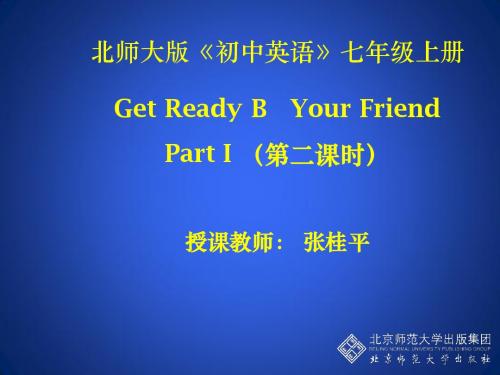
Get Ready B Your Friend
Part I (第二课时)
授课教师: 张桂平
What’s his name?
Jim
What’s her name? Is she Jim’s sister? Where is she from? How many people are there in her family? Who are they? What is her favourite subject? What is she good at?
Homework
1. 练习口头表达数字,默写数 字1-20; 2.完成介绍你自己和朋友的文 段。(Worksheet Ex. Ⅲ)
1 2
Listen to the dialogue and write the ages of the children. (Ex. 8) Bob_____ 9
15 Jeff______
Jenny_____ 14 Jim______ 12
11 Linda_____
In pairs, make a dialogue to know about your partner and his/her friend.
人称代词
“谁”
I am from America. You are from Canada. He is from Australia. She is from England. They are from China. We are good friends. It is my favorite song.
A game: Say the players’ numbers.
seventeen
北师大版英语七年级上册Get Ready D Period1 精品教案
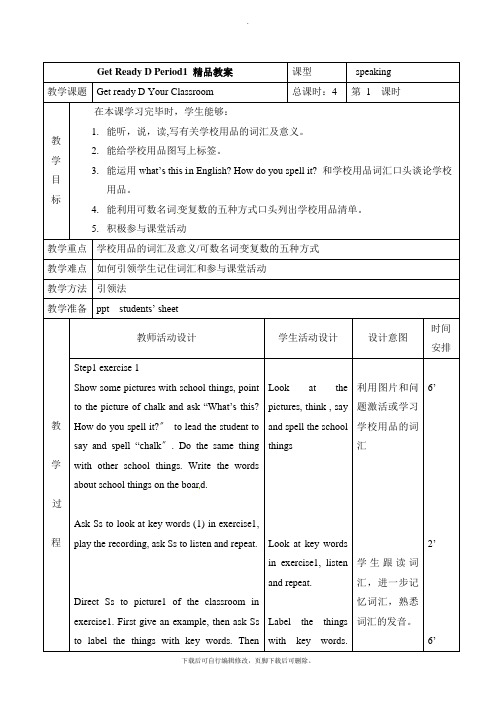
Get Ready D Period1 精品教案课型speaking 教学课题Get ready D Your Classroom 总课时:4 第 1 课时教学目标在本课学习完毕时,学生能够:1.能听,说,读,写有关学校用品的词汇及意义。
2.能给学校用品图写上标签。
3.能运用what’s this i n English? How do you spell it? 和学校用品词汇口头谈论学校用品。
4.能利用可数名词变复数的五种方式口头列出学校用品清单。
5.积极参与课堂活动教学重点学校用品的词汇及意义/可数名词变复数的五种方式教学难点如何引领学生记住词汇和参与课堂活动教学方法引领法教学准备p pt students’ sheet教学过程教师活动设计学生活动设计设计意图时间安排Step1 exercise 1Show some pictures with school things, pointto the pict ure of chalk and ask “What’s this?How do you spell it?〞to lead the student tosay and spell “chalk〞. Do the same thingwith other school things. Write the wordsabout school things on the board.Ask Ss to look at key words (1) in exercise1,play the recording, ask Ss to listen and repeat.Direct Ss to picture1 of the classroom inexercise1. First give an example, then ask Ssto label the things with key words. ThenLook at thepictures, think , sayand spell the schoolthingsLook at key wordsin exercise1, listenand repeat.Label the thingswith key words.利用图片和问题激活或学习学校用品的词汇学生跟读词汇,进一步记忆词汇,熟悉词汇的发音。
- 1、下载文档前请自行甄别文档内容的完整性,平台不提供额外的编辑、内容补充、找答案等附加服务。
- 2、"仅部分预览"的文档,不可在线预览部分如存在完整性等问题,可反馈申请退款(可完整预览的文档不适用该条件!)。
- 3、如文档侵犯您的权益,请联系客服反馈,我们会尽快为您处理(人工客服工作时间:9:00-18:30)。
清辅音后读|s| park- parks pen-pens
book-books
浊辅音和元音后读|z| photo---photos piano---pianos radio---radios car-cars bag-bags 后面加es的就读|iz| bus-buses watch-watches box-boxes wife-wives knife---knives
What's this?
It's a classroom.
What's this in English? It's a blackboard. It's a door
What's this in English? How do you spell it? It's a ruler. R-U-L-E-R.
拼写规则
加s
加 es
y变i, 加 es f变v , 加 es
woman
child
women
children
不规则变化
DVD player chalk plant recorder TV watch window door desk chair shelf
two DVD players three chalks four plants five recorders six TVs seven watches eight windows nine doors fourty desks fourty-one chairs two shelves
A: Where are the pencils? B: They are in the backpack .
单数 book chair desk DVD player class box brush watch dictionary shelf man
复数 books chairs desks DVD players classes boxes brushes watches dictionaries shelves men
DVD player chalk plant recorder TV watch window door desk chair shelf
播放器 粉笔 植物 录音机 电视机 钟表 窗户 门 桌子 椅子 书架
schoolbag exercise book pencil book eraser pen ruler dictionary picture
书包 练习本 铅笔 书 橡皮 钢笔 尺子 字典 图片
Where is my basketball?
It’s under the desk.
Where’s the plant? It’s on the table.
Where are the apples?
They’re on the table.
schoolbag exercise book pencil book eraser pen ruler dictionary picture
twenty schoolbags fifty exercise books eighty pencils ninty books five erasers eleven pens sixty rulers two dictionaries three pictures
Is it above the box? Yes, it is.
Is it above the box? No, it isn't.
Don't look at your books. 不要看你的书。 Don't read the dialogue. 不要读对话。 Look at the pictures. 请看图片。 Stand up 起立。 Sit down. 坐下。 Write the words in your exercise b
